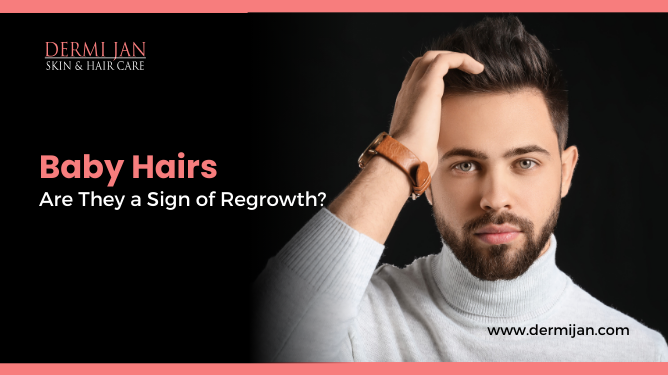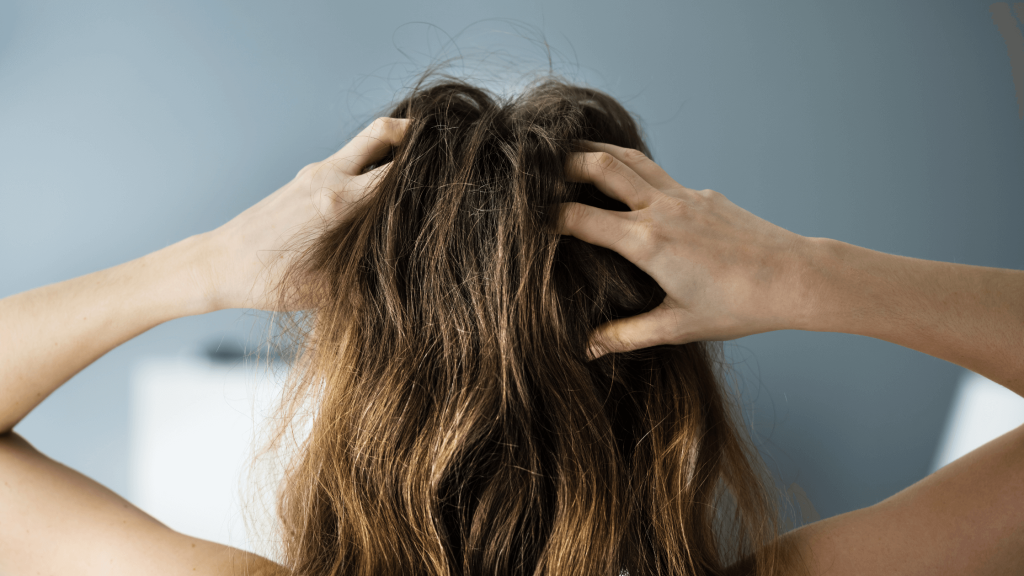



Discovering baby hairs along your hairline can often leave you wondering: are these a sign of hair regrowth or simply a natural part of your hair pattern? This common question plagues many individuals concerned about hair loss or overall hair health. Join us as we dive deep into the mysteries surrounding baby hairs and their possible connection to regrowth.
In the following sections, we will explore the nature of baby hairs, their growth cycle, and the factors influencing their appearance. We’ll also discuss how to accurately identify signs of hair regrowth and offer valuable tips on nurturing your scalp for optimal hair growth. So, let’s embark on this fascinating journey to uncover the truth behind regrowth baby hairs and how they impact your hair’s well-being!
Baby hairs are often misunderstood, yet play an essential role in hair growth. In this section, we will be exploring what baby hairs are, the hair growth cycle, and how to differentiate baby hairs from breakage.
Baby hairs are the short, fine, and soft hairs that typically grow along the hairline. They can vary in length and texture, but are often characterized by their softness and lack of pigment, which distinguishes them from the rest of your hair. While baby hairs can be a natural part of your hairline, they can also be an indicator of new hair growth, making it essential to understand their appearance and growth patterns.
All hair goes through a natural growth cycle, which consists of three phases: anagen, catagen, and telogen. The anagen phase is the active growth stage, where hair follicles push out new hair strands. This phase can last between two and seven years, dictating the maximum length of your hair. The catagen phase occurs when the hair follicle shrinks and disconnects from the blood supply, preparing the hair strand for the resting stage. This phase typically lasts two to three weeks.
Lastly, the telogen phase sees hair strands detach from the follicles, allowing them to be shed naturally. This resting period can range from two to four months. Understanding the hair growth cycle is crucial in comprehending how baby hairs contribute to hair regrowth.
Differentiating between baby hairs and hair breakage is essential, as it can help you manage your hair’s health more effectively. Baby hairs are generally shorter than the rest of your hair, with a soft texture and appearance. Breakage, on the other hand, can occur anywhere along the hair shaft and may appear frayed, split, or rough in texture.
A key factor in distinguishing baby hairs from breakage is their placement – baby hairs usually grow along the hairline and temples, while breakage can happen at any length with no specific pattern. By familiarizing yourself with these characteristics, you can better assess your hair’s growth and health, allowing you to take appropriate steps for maintaining strong, healthy locks.
There are a variety of reasons why baby hairs appear, ranging from new hair growth to natural hairline patterns. Understanding the root causes of baby hairs can provide valuable insights into their relationship with regrowth. Let’s explore the factors that contribute to the appearance and growth of these delicate strands.
Genetics play a significant role in determining our hair characteristics, including thickness, color, and growth patterns. Some individuals may naturally have more baby hairs due to their unique genetic makeup. Therefore, it’s essential to take into account that genetic factors can influence the number and appearance of baby hairs around the hairline.
Aging affects almost every aspect of our bodies, and our hair is no exception. As we age, our hair tends to become thinner and may experience a gradual increase in baby hairs. Hormonal changes associated with aging can impact the hair growth cycle, contributing to the emergence of baby hairs and potentially altering hair density.
Hormonal changes throughout various life stages, such as pregnancy and menopause, can also affect our hair’s growth and appearance. Imbalances in hormones like estrogen, testosterone, and thyroid hormones may lead to noticeable changes in hair characteristics, including the presence of baby hairs. In these cases, baby hairs may not be directly tied to hair regrowth but rather a result of fluctuating hormone levels.
Moreover, external factors like hairstyling habits and environmental stressors can influence baby hair growth. For instance, tight hairstyles that pull at the hair follicles can cause hair breakage and damage, leading to an increase in baby hairs. Similarly, exposure to harsh chemicals and environmental pollutants can weaken the hair shaft, contributing to the growth of baby hairs.
As we can see, baby hairs may be a sign of hair regrowth, but they can also result from various other causes, some of which are natural and others external. In the next section, we will explore the potential link between baby hairs and regrowth, discussing the characteristics and conditions necessary for true hair regrowth to occur. Stay with us as we delve deeper into the fascinating world of baby hairs and their role in hair health.

Body sculpting with radio frequency is a non-surgical method that uses targeted radio frequency energy to heat the deeper layers of the skin, stimulating collagen production and promoting tissue tightening. This treatment can effectively tighten the skin and improve body contours without the need for surgery. It is a popular choice for individuals seeking a non-invasive and relatively painless option for body tightening.
While the presence of baby hairs alone might not be sufficient to prove new hair growth, some key factors can help substantiate regrowth. Pay attention to your hair’s overall density and fullness, as increased thickness may indicate new hair coming in. Similarly, a healthy scalp free of irritation and flaking can be a good sign that new growth is underway. Be vigilant in observing your hairline, taking note of any new, short, and wispy hairs that appear, as these may be indicators of regrowth hair baby hairs. Remember, consistency and patience are essential in monitoring any changes in your hair’s appearance and health.
It’s crucial to distinguish baby hairs emerging from regrowth from those caused by frizz, as the two can often be confused. The main difference lies in the texture and appearance of the hair strands: new hair growth, or “true” baby hairs, are typically fine, soft, and wispy, while frizz occurs when hair strands become dry, tangled, and unruly due to external factors like humidity and hair products. To determine whether you’re dealing with regrowth or frizz, assess your hair’s overall condition, texture, and environment. Accurately identifying the source of baby hairs elevates your understanding of your hair’s health and sheds light on any potential underlying issues that may require attention.
In conclusion, while baby hairs might not always be a direct sign of regrowth, their presence can serve as a prompt to closely monitor and evaluate your hair’s density, scalp health, and overall well-being. Properly identifying the cause of are baby hairs and a sign of regrowth can empower you to make informed decisions about your hair care routine and make any necessary adjustments to improve the health of your hair and scalp.

A healthy scalp environment is essential for promoting hair regrowth and preventing hair loss. In this section, we’ll discuss the importance of proper scalp care and provide practical advice to help you nurture your scalp and encourage the growth of those precious baby hairs.
First and foremost, a good scalp care routine should include cleansing, exfoliating, and moisturizing techniques tailored to your hair type. Regularly cleansing your scalp helps to remove dirt, excess oil, and product buildup that can clog hair follicles and lead to hair loss. Make sure to choose a gentle, sulfate-free shampoo that won’t strip your hair and scalp of their natural oils. Exfoliating your scalp at least once a week can also help to remove dead skin cells and promote healthy hair growth. You can use a scalp scrub, a scalp brush, or simply your fingertips to gently massage your scalp in circular motions while shampooing.
Moisturizing your scalp is just as important as cleansing and exfoliating. Dry scalp conditions can lead to dandruff, itchiness, and even hair loss. Look for products containing nourishing ingredients such as argan oil, shea butter, and aloe vera to help maintain a healthy moisture balance on your scalp. Additionally, consider incorporating soothing and moisturizing treatments like scalp masks and leave-in conditioners into your routine to enhance overall hair health.
Beyond scalp care, lifestyle changes and proper nutrition play a significant role in supporting hair health. Embrace a balanced diet rich in vitamins and minerals to ensure optimum hair growth conditions. Focus on consuming foods high in biotin, vitamin D, iron, and zinc, as these nutrients are essential for hair health. You can also consider taking supplements specifically designed for hair growth.
Maintaining a healthy scalp is key to increasing the appearance of baby hairs and encouraging overall hair regrowth. By establishing a diligent scalp care routine and making lifestyle and dietary adjustments, you can create the ideal environment for your hair to thrive. With time, patience, and consistent care, those baby hairs signify a promising hair regrowth journey ahead.
Medical treatments for hair regrowth, like minoxidil and finasteride, are popular and proven to deliver results for many individuals. However, they often require a prescription and can be costly. On the other hand, natural at-home remedies, such as essential oils and herbal treatments, may be more affordable but can produce varying results depending on the individual. It’s essential to weigh the pros and cons of each approach and choose one that aligns with your needs, budget, and desired results.
Promoting the regrowth of baby hairs involves more than just applying topical treatments. Some simple, actionable tips include: – Leading a healthy lifestyle and managing stress levels to maintain overall hair health – Avoiding tight hairstyles, aggressive brushing, or excessive heat styling to minimize hair damage and breakage – Massaging the scalp gently to stimulate blood circulation and encourage hair growth – Consuming a balanced diet rich in vitamins, minerals, and essential fatty acids to support hair health from the inside out.
Various home remedies can help nourish hair follicles and create a healthy environment for regrowth. These include: – Integrating natural oils, such as castor, coconut, or peppermint oil, into your scalp care routine – Experimenting with herbal treatments like aloe vera, green tea, or rosemary extract to soothe and invigorate the scalp – Performing gentle scalp massages to stimulate blood flow and strengthen the hair follicles.
In conclusion, when it comes to fostering regrowth of baby hairs, it is important to consider the various treatments and remedies available and choose one that aligns with your individual needs. With proper care, patience, and consistency, you can create an optimal environment for new hair growth, ultimately leading to healthier, fuller, and more resilient hair.
The delicate balance of hormones in our body plays a critical role in the health of hair follicles and the growth of baby hairs. Hormones such as estrogen, testosterone, and thyroid hormones can significantly impact hair growth patterns and the appearance of baby hairs. An imbalance in these hormones can lead to hair loss or hinder regrowth hair baby hairs.
Lifestyle factors also greatly influence hair health and the potential for regrowth. Stress can disrupt hormonal balance, contributing to hair loss and negatively affecting hair growth. Ensuring adequate sleep is essential, as it helps regulate stress hormone levels and supports proper hair growth. Moreover, regular exercise can increase blood flow to the scalp and boost hair health. Finally, a balanced diet rich in vitamins, minerals, and proteins is an integral part of maintaining hair health and promoting regrowth.
Various scientific research and studies have highlighted the link between hormonal and lifestyle factors to hair growth outcomes. For instance, research has shown that hormonal imbalances caused by thyroid disorders can directly lead to hair loss and affect the growth of baby hairs. Additionally, studies have found connections between stress-induced hair loss and hair regrowth, emphasizing the importance of managing stress levels and adopting a balanced lifestyle.
In conclusion, understanding how hormones and lifestyle factors affect regrowth is vital to implementing personalized hair care routines that cater to your hair’s unique needs. By maintaining hormonal balance and adopting a healthy lifestyle, one can foster a favorable environment for hair regrowth and enhance the overall health and appearance of baby hairs.
In this article, we explored the intriguing topic of baby hairs and their association with hair regrowth. The significance of these delicate, fine hairs is often misunderstood, yet they can provide us with critical insights into our hair health and overall scalp conditions, as well as serve as a potential indicator of new hair growth.
As we discussed earlier, baby hairs can be part of one’s natural hairline or be a sign of regrowth, depending on individual factors. The key is determining the nature of your baby hairs, which involves observing their texture, length, and appearance, as well as identifying any possible factors contributing to their growth – such as hormones, lifestyle, and hair care habits.
Ultimately, nurturing your hair health and scalp environment is vital for maintaining and enhancing hair regrowth. Adopting a consistent, holistic approach to hair care, including proper scalp cleansing, hair-protecting routines, and well-balanced nutrition, will encourage the growth of healthy baby hairs and contribute to the overall resilience of your tresses. We encourage you to continue exploring this fascinating subject and seek knowledge on how to best support the health and vitality of your hair.
Baby hairs are the short, fine, and soft hairs that typically grow along the hairline. They have a different texture and appearance compared to the rest of the hair on the scalp.
In some cases, baby hairs can indeed be a sign of new hair growth. However, they can also be a natural part of one’s hairline, or be caused by factors such as hair styling habits and genetics.
To distinguish between baby hairs and hair breakage, look at factors like hair texture, length, and location. Baby hairs are typically softer and finer, while hair breakage often feels coarse or brittle, and may occur throughout the hair’s length.
There are various treatments available for hair regrowth, including over-the-counter solutions, prescription medications, and natural home remedies. The effectiveness of each treatment may vary from person to person.
Hormones like estrogen, testosterone, and thyroid hormones play a crucial role in hair growth patterns and the appearance of baby hairs. Lifestyle factors, such as stress, sleep, exercise, and diet, can also impact hair health and the potential for regrowth.
Focus on having a consistent and holistic approach to hair care, which includes a balanced diet, proper hair care practices, and managing stress levels. Regular scalp care routines, lifestyle adjustments, and using the right hair care products can all contribute to a healthy hair and scalp environment.